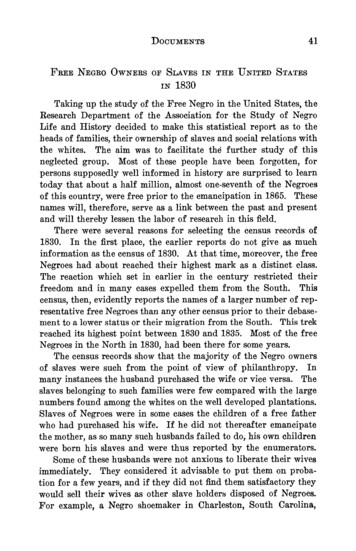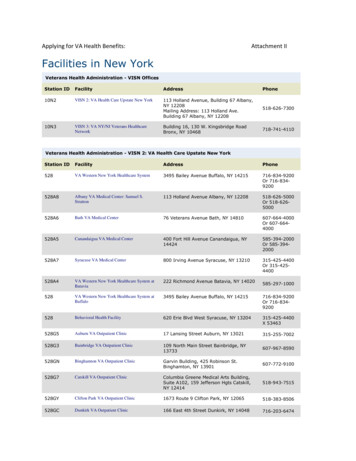
Transcription
SLAVEHOLDERS AND SLAVES OF HEMPSTEAD COUNTY, ARKANSASKelly E. Houston, B.A.Thesis Prepared for the Degree ofMASTER OF ARTSUNIVERSITY OF NORTH TEXASMay 2008APPROVED:Randolph B. Campbell, Major ProfessorD. Harland Hagler, Committee MemberRichard B. McCaslin, Committee MemberAdrian R. Lewis, Chair of the Department ofHistorySandra L. Terrell, Dean of the Robert B.Toulouse School of Graduate Studies
Houston, Kelly E. Slaveholders and Slaves of Hempstead County,Arkansas. Master of Arts (History), May, 2008, 104 pages, 20 tables, 5 maps,bibliography, 61 titles.A largely quantitative view of the institution of slavery in HempsteadCounty, Arkansas, this work does not describe the everyday lives of slaveholdersand slaves. Chapters examine the origins, expansion, economics, and demise ofslavery in the county. Slavery was established as an important institution inHempstead County at an early date. The institution grew and expanded quicklyas slaveholders moved into the area and focused the economy on cottonproduction. Slavery as an economic institution was profitable to masters, but itmay have detracted from the overall economic development of the county.Hempstead County slaveholders sought to protect their slave property bysupporting the Confederacy and housing Arkansas’s Confederate governmentthrough the last half of the war.
Copyright 2008ByKelly E. Houstonii
TABLE OF CONTENTSPageLIST OF TABLES .ivLIST OF MAPS . vChapters1.INTRODUCTION . 12ORIGINS OF SLAVERY IN ARKANSAS AND HEMPSTEAD COUNTY . 113.GROWTH AND EXPANSION: SLAVERY IN ARKANSAS ANDHEMPSTEAD COUNTY FROM STATEHOOD TO SECESSION. 274.THE ECONOMICS OF SLAVERY IN HEMPSTEAD COUNTY . 525.SECESSION AND THE END OF SLAVERY IN ARKANSAS ANDHEMPSTEAD COUNTY . 73APPENDIX . 82BIBLIOGRAPHY . 100iii
LIST OF TABLESPage1.Total, Free, and Slave Populations of Arkansas and Hempstead County, 1840,1850, and 1860. 282.Places of Birth Listed of 100 Hempstead County Slaveholders, 1860. 333.Occupations of 100 Hempstead County Slaveholders, 1860 . 344.Distribution of Hempstead County Slaveholdings, 1840, 1850, and 1860 . 355.Distribution of Hempstead County Slaves According to Size of Slaveholding,1840, 1850, and 1860. 366.Occupations of Hempstead County Planters, 1850 . 377.Places of Birth Listed for Hempstead County Planters, 1850 . 388.Occupations of Hempstead County Planters, 1860 . 389.Places of Birth Listed for Hempstead County Planters, 1860 . 3910.Taxes Paid by Fifteen Hempstead County Slaveholders, 1850, 1856, and 1860. 4111.Productions of Hempstead County Agriculture, 1850 and 1860 . 4412.Appraised Value of Slaves of Robert Carrington Estate, 1845 . 5413.Appraised Value of Slaves of Edward Johnson Estate, 1844 . 5614.Mean Value of Slaves in Hempstead County, 1840s, 1850s, and 1860s . 5715.Appraised Value of Slaves of Jacob Powell Estate, 1863 . 5816.Cotton Productivity per Slave, 1850 and 1860. 6317.Calculation of the Value of Land per Slave among Cotton Planters, 1850 and1860 . 6418.Cost of Non-Slave Investment per Slave among Cotton Planters, 1850 and 1860. 6519.Rate of Return per Slave among Cotton Planters, 1850 and 1860. 6620.Food Crop and Cotton Production by Hempstead County Farmers, 1850 and1860 . 70iv
LIST OF MAPSPage1.Hempstead County, Arkansas . 102.Posts of Eighteenth-Century Arkansas. 123.Slave Populations of Arkansas Counties, 1840 . 494.Slave Populations of Arkansas Counties, 1850 . 505.Slave Populations of Arkansas Counties, 1860 . 51v
CHAPTER 1INTRODUCTIONOn the eve of the American Civil War, one in four Arkansas residents lived inbondage. They toiled in every corner of the state that supported the cultivation of “KingCotton,” especially in the lowlands of the Mississippi Delta. On the fringes of the frontier,Arkansas’s slave society was healthy and growing when Confederate defeat brought anend to the institution in 1865. With fewer than three decades in the union as a slavestate, Arkansas may have had a short history with slavery when compared to the slavestates of the southeast, but the legacy of this history is no less important.1However, the institution of slavery in Arkansas has received relatively littleattention from historians. Perhaps this neglect is not surprising, as scholars havenotoriously overlooked the Trans-Mississippi states in respect to other topics ofsouthern history, such as the Civil War and Reconstruction. While overlooking thehistory of slavery in Arkansas may not be unusual, it is unwarranted, as the institutionwas a central factor in Arkansas’s economic development.The evolution of American slavery scholarship can be viewed in the context ofthree important studies—American Negro Slavery by U. B. Phillips, The PeculiarInstitution by Kenneth Stampp, and Many Thousands Gone by Ira Berlin. While manyother significant studies exist, these works appropriately represent the changes intwentieth-century understanding of American slavery, and their influence continues toguide historians of the twenty-first. 21United States Bureau of the Census, Population of the United States in 1860: Compiled fromthe Original Returns of the Eighth Census (Washington, D. C.: Government Printing Office, 1864), 18.2Ulrich B. Phillips, American Negro Slavery: A Survey of the Supply, Employment and Control ofNegro Labor as Determined by the Plantation Regime (New York: D. Appleton and Company, 1918);1
The first comprehensive study of American slavery emerged in 1918, when U. B.Phillips published American Negro Slavery. Based on the thorough investigation of awide variety of sources from all over the South, Phillips made many observations aboutAmerican slavery. Perhaps most important of these was his insistence that theinstitution was unprofitable for individual slaveholders and the South as a whole, as wellas his contention that slavery was a generally benevolent institution. Phillips establisheda lingering view of American slavery that remained free of serious challenges for manyyears.Although some works called into question some of Phillips’s ideas during the1940s, the most crushing blow to his thesis came in 1956, when Kenneth Stampppresented a groundbreaking approach to American slavery with the publication of ThePeculiar Institution. Stampp’s conclusions were revolutionary because he attempted todescribe slavery from the viewpoint of the slaves as closely as possible. He emphasizedthe hardships experienced by those in bondage and characterized slavery not as benignand unprofitable, but instead as exploitative and lucrative.Ira Berlin’s Many Thousands Gone, published in 1988, represents the school ofthought that has emerged in recent decades. By describing slavery’s development indifferent regions of North America, Berlin demonstrated that American slavery was aninteractive and evolving institution that varied with time and location, rather than a statichistorical event. This outlook on the peculiar institution can be found in recent slaverystudies.Kenneth M. Stampp, The Peculiar Institution: Slavery in the Antebellum South (New York: Alfred A.Knopf, 1956); Ira Berlin, Many Thousands Gone: The First Two Centuries of Slavery in North America(Cambridge: The Belknap Press of Harvard University Press, 1988).2
The work of historian Orville W. Taylor dominates the scholarship of Arkansasslavery. His publication of Negro Slavery in Arkansas in 1958 established the first andonly comprehensive treatment of the subject. Taylor’s interpretation was part of agrowing challenge to the prevailing version of the history of American slavery that hadbeen established by U.B. Phillips and his adherents, but it did not totally endorse theviews of Kenneth Stampp. Falling between Phillips and Stampp, Taylor’s analysisworked against the characterization of slavery as a benign institution and stressedslavery’s profitability, but downplayed the cruelty of masters. Almost fifty years later,Taylor’s work remains the only book-length study of slavery in Arkansas. 3The Arkansas Historical Quarterly has published several articles dealing withspecific Arkansas slavery topics. “An Urban Slave Community: Little Rock, 1831-1862”by Paul D. Lack turned from agricultural slavery to uncover the nature of enslavement inArkansas’s capital city. John S. Otto’s “Slavery in the Mountains: Yell County, Arkansas,1840-1860” and Gary Battershell’s “The Socioeconomic Role of Slavery in the ArkansasUpcountry” addressed the institution outside of its most familiar place in the Arkansaslowlands. William VanDeburg delved deeper into the social issues with “The SlaveDrivers of Arkansas: A New View From the Narratives.” “Arkansas Slaveholdings andSlaveholders in 1850” by Robert Walz, provides an immensely useful statewidequantitative profile of slavery in the important decade between 1850 and 1860. Finally,3Orville Taylor, Negro Slavery in Arkansas (Durham: Duke University Press, 1958). For a morecomplete discussion of how Taylor’s work fits into the historiography of American slavery, see Carl H.Moneyhon’s introduction to Orville Taylor, Negro Slavery in Arkansas (Fayetteville: University ofArkansas Press, 2000).3
Orville W. Taylor’s “Baptists and Slavery: Relationships and Attitudes” supplements hispreviously published research on the topic. 4Recent interpretations of the institution of slavery in Arkansas can be found in a1999 edition of the Arkansas Historical Quarterly that focused specifically on the topic.The issue includes two important articles concerning the slave family in Arkansas andthe role of slavery in Arkansas’s overall development. “The Slave Family in Arkansas,”by Carl H. Moneyhon, characterizes the community created by Arkansas slave families,emphasizing the affection between family members in spite of their uncertaincircumstances. S. Charles Bolton’s “Slavery and the Defining of Arkansas” explainsthat although slavery may not have been as dominant and widespread as in othersouthern states, it was a pervasive influence in the state’s development. 5A judicious treatment of the subject of Arkansas slavery can be found in twosignificant books on Arkansas history—also by Bolton and Moneyhon. Published in1998, Bolton’s Arkansas, 1800-1860: Remote and Restless includes a chapter entitled“Human and Chattel” that effectively provides a description of slave life in Arkansas.Incorporating WPA slave narratives into his sources, Bolton attempted to view slaverythrough the lens of the slaves themselves. The Impact of the Civil War and4Paul D. Lack, “An Urban Slave Community: Little Rock, 1831-1862,” Arkansas HistoricalQuarterly 41 (Spring, 1982): 258-87; John S. Otto, “Slavery in the Mountains: Yell County, Arkansas,1840-1860,” Arkansas Historical Quarterly 39 (Spring, 1980): 35-52; Orville W. Taylor, “Baptists andSlavery: Relationships and Attitudes,” Arkansas Historical Quarterly 39 (Autumn, 1979): 199-226; RobertB. Walz, “Arkansas Slaveholdings and Slaveholders in 1850,” Arkansas Historical Quarterly 12 (Spring,1953): 38-74; William VanDeburg, “The Slave Drivers of Arkansas: A New View From the Narratives,”Arkansas Historical Quarterly 25 (Autumn, 1976): 231-245; Gary Battershell, “The Socioeconomic Role ofSlavery in the Arkansas Upcountry,” Arkansas Historical Quarterly 58 (Spring, 1999): 45-60.5S. Charles Bolton, “Slavery and the Defining of Arkansas,” Arkansas Historical Quarterly 28(Spring, 1999): 1-23; Carl H. Moneyhon, “The Slave Family in Arkansas,” Arkansas Historical Quarterly28 (Spring, 1999): 24-44; This issue of the Arkansas Historical Quarterly also includes: Gary Battershell,“The Socioeconomic Role of Slavery in the Arkansas Upcountry,” Arkansas Historical Quarterly 28(Spring, 1999): 45-60 and Ted J. Smith “Mastering Farm and Family: David Walker as Slaveholder,”Arkansas Historical Quarterly 28 (Spring, 1999): 61-79.4
Reconstruction on Arkansas, published in 1994 by Carl Moneyhon, begins with an indepth survey of antebellum Arkansas in which the role of slavery is highlighted and welldocumented. 6A recently published monograph on Arkansas history has done much to furtherthe scholarship of antebellum Arkansas—Donald P. McNeilly’s The Old South Frontier:Cotton Plantations and the Formation of Arkansas Society, 1819-1861. McNeilly arguesthat the development of Arkansas society was dominated by an ever-strengtheningplanter class supported by slavery. Focusing on the Arkansas lowlands, the chapterentitled “Slavery on the Cotton Frontier” provides an overview of slavery in thedevelopment of the region and includes insight into the daily experiences of the slaves.McNeilly emphasizes slavery as the basis of the economic and social evolution ofArkansas and demonstrates how slaveholders managed to gain and keep a firm grip onArkansas society. While The Old South Frontier highlights the importance of slavery inArkansas and employs modern research methods, it has not erased the need for furtherscholarship on the topic of Arkansas slavery. 7Thus, slavery in Arkansas has not been wholly ignored by historians in recentyears, and advances have been made toward a greater understanding of slavery in thestate. But more work is needed. A case study focusing on the institution in a singlecounty in Arkansas—Hempstead County, for example—is a useful step toward givingthis issue the detailed attention that it deserves. By examining slaves and slaveholders6S. Charles Bolton, Arkansas, 1800-1860: Remote and Restless (Fayetteville: University ofArkansas Press, 1998); Carl H. Moneyhon, The Impact of the Civil War and Reconstruction on Arkansas(Baton Rouge: Louisiana State University Press, 1994).7Donald P. McNeilly, The Old South Frontier: Cotton Plantations and the Formation of ArkansasSociety, 1819-1861 (Fayetteville: University of Arkansas Press, 2000).5
in Hempstead County during the statehood period, the nature of the institution inArkansas can be studied in microcosm.Hempstead County is an appropriate choice for such a study because slaveryhad a strong presence there from an early date. Favored with fertile soil and a waterroute into Louisiana, the county led Arkansas counties in slave population in 1830, sixyears before the territory became a state. Although the southeastern riverfront countiesalong the Mississippi came to far surpass Hempstead County in slaveholding and cottonproduction, it continued as one of Arkansas’s top slaveholding counties through theantebellum years. 8In addition to its position as an important slaveholding region, Hempstead Countyhas a wealth of historical records for the study of the peculiar institution in microcosm.The Hempstead County courthouse has never burned, allowing for the survival of manylocal records, which can supplement United States Census information. Thus, thesources to support a county-level investigation of slaves and slaveholders inHempstead County make it a prime subject. 9The purpose of this county-level study is to examine the institution of slavery andits economic importance during the statehood period. Understanding the growth of theinstitution is essential. Did the institution of slavery grow or weaken in HempsteadCounty? Expansion might hint at profitability and significance, while a weakening wouldsuggest that slavery was unprofitable or unimportant. How did the growth of slavery inHempstead County relate to the institution’s development statewide? This kind ofcontext is needed to understand the statistics of slavery in Hempstead County. And,8Taylor, Negro Slavery in Arkansas, 26.Historical sources for Hempstead County and several other southwestern Arkansas countiescan be found at the Southwest Arkansas Regional Archives, located in Washington, Arkansas.96
because slavery in Arkansas was primarily part of the cotton economy, how did cottonproduction relate to the growth of slavery in the county?In addition to detailing the evolution of slavery in Hempstead County, this studymust explain the nature of the county’s slaveholdings. Who were the slaveholders, andhow many slaves did they own? Who were the planters? How large were theirslaveholdings? How did these holdings change over time? By answering thesequestions and analyzing the answers in the context of the state and the South, acounty-level study of slavery in Hempstead County can add significantly to theunderstanding of Arkansas’s history with the institution.It is important to note that this study is limited to what can be deemed an“outside” view of the institution of slavery in Hempstead County. This is because there isno attempt to describe the personal experiences or conditions of the slaveholders orslaves themselves. Political concerns are also omitted. The approach is instead largelystatistical in nature and analyzes the institution according to “outside” sources.Information drawn from tax rolls, census reports, and court records is used to trace andexplain the economic growth of slavery in Hempstead County without attention topersonal papers or slave narratives. While this approach is impersonal, it is an effectiveway to focus on the economic importance of slavery in the county’s history.Hempstead County, Arkansas, was organized as part of Missouri Territory in1818, taking its name from the territory’s first delegate to Congress, EdwardHempstead. At its original size, Hempstead County encompassed a huge portion ofsouthwest Arkansas, stretching south and west of the Little Missouri River, directlysouth to Louisiana, and west to Indian Territory. At its much smaller present size (see7
Map 1), Hempstead County spans about 730 square miles. This paper will refer to thecounty as it was organized between 1850 and 1860, which is smaller than the earliestsize because of the loss of land to neighboring counties, but slightly larger than thepresent-day county. 10Arkansas Territory was organized in 1819, and immigrants to Hempstead Countywere only part of the increasing flow of settlers to the region in the following decades.By keelboat and flatboat, individuals and families came to settle along the Red River atFulton, Hempstead County’s oldest settlement. In 1832, the “military road” was cut fromLittle Rock southwest to Washington, Hempstead’s county seat. By 1838, the “raft,” adangerous and inhibiting mass of debris and driftwood, was cleared from the Red River,allowing for easier steamboat transportation of goods and people in and out of thecounty. Around the same time, a tri-weekly stagecoach began operation between LittleRock and Washington. These improvements in transportation helped boost thepopulation of Hempstead County, which grew to 4,921 by 1840. 11Washington, the most important town in the county, served as a stopping pointalong the “Southwest Trail” that led into Texas. Its history begins as early as 1818 withthe establishment of a tavern for travelers. The town was sparsely populated by the10Biographical and Historical Memoirs of Southern Arkansas (Chicago: The GoodspeedPublishing Company, 1890), 377-379; Gerald T. Hanson and Carl H. Moneyhon, Historical Atlas ofArkansas (Norman: University of Oklahoma Press, 1989), 29-31.11S. Charles Bolton, Arkansas, 1800-1860: Remote and Restless (Fayetteville: University ofArkansas Press, 1998) 25; Biographical and Historical Memoirs of Southern Arkansas (Chicago: TheGoodspeed Publishing Company, 1890) 384-385; Robert B. Walz, “Migration into Arkansas, 1820-1880:Incentives and Means of Travel,” Arkansas Historical Quarterly 17 (Winter, 1958): 315-320; WalterMoffatt, “Transportation into Arkansas, 1819-1840,” Arkansas Historical Quarterly 15 (Autumn, 1956):192; Fifth Census of the United States, Population Schedule; Hanson and Moneyhon, Historical Atlas ofArkansas , 32-33.8
same people who would later comprise Hempstead County’s slaveholding and planterclass. 12Washington firmly established itself as the county seat by the 1830s and servedas the site of many intriguing historical events—both real and imagined. Two popularfigures of Texas history have made their marks on the area. Legend has it that GeneralSam Houston spent time at the tavern in Washington in the 1830s, surrounded by othermysterious personalities who were looking to gather support for a mission to stirrevolution in Texas. Historian Francis Irby Gwaltney went so far as to refer toWashington as the “birthplace of the Texas Revolution.” In addition to Sam Houston’scameo appearance in the folk history of Hempstead County, the “Bowie Knife” is also afavorite among many locals who believe that the legendary knife was first forged in ablacksmith shop in Washington. 13Washington increased in importance and served as a resting place for travelersas well as a commercial center for locals. By 1863, Washington would develop into abustling—albeit frontier—town with enough dedication to slavery to serve as Arkansas’sConfederate capital for the last few years of the Civil War. How did the county get to thispoint? The answer may be found in the examination of slaveholders and slaves ofHempstead County.1412Francis Irby Gwaltney, “A Survey of Historic Washington, Arkansas,” Arkansas HistoricalQuarterly 17 (Winter, 1958): 337-394; Thomas A. Deblack, With Fire and Sword: Arkansas, 1861-1874(Fayetteville: University of Arkansas Press, 2003) 4, 202.13Gwaltney, “A Survey of Historic Washington, Arkansas” Arkansas Historical Quarterly 17(Winter, 1958): 338-341.14Gwaltney, “A Survey of Historic Washington, Arkansas,” 337-394; Thomas A. DeBlack, WithFire and Sword: Arkansas, 1861-1874 (Fayetteville: University of Arkansas Press, 2003) 4, 202.9
Map 1Hempstead County, Arkansas10
CHAPTER 2ORIGINS OF SLAVERY IN ARKANSAS AND HEMPSTEAD COUNTYThe first slaves to enter the modern boundaries of Arkansas arrived while thearea was still part of French Louisiana. Orville Taylor wrote that they came with settlersrecruited by a stock enterprise called the Western Company, chartered in 1717. A groupof Germans, who were recruited to settle along the Arkansas River, brought slaves tothe area near Arkansas Post in 1720 (See Map 2). This early settlement, called Law’sColony, was short-lived because the community was too distant from a steady source ofsupplies, and the Germans deserted the area in favor of settlements closer to NewOrleans. 15In recent years, the above story has been disputed. According to research bylegal historian Judge Morris S. Arnold, the Germans never arrived to Law’s concession,and the settlement never amounted to more than a small group of Frenchmen andindentured servants. By April of 1723—whether the Germans actually arrived or not—Law’s concession was deserted, although a few settlers with slaves remained in thevicinity of Arkansas Post. 1615OrvilleTaylor, Negro Slavery in Arkansas, (Fayetteville: University of Arkansas Press, 2000), 612; Donald P. McNeilly, The Old South Frontier: Cotton Plantations and the Formation of ArkansasSociety, 1819-1861, (Fayetteville: University of Arkansas Press, 2000), 46.16Morris S. Arnold, Colonial Arkansas, 1686-1804: A Social and Cultural History, (Fayetteville:University of Arkansas Press,1991), 9-17; Taylor, Negro Slavery in Arkansas, 12.11
Arkansas Post, located in southeastern Arkansas, was the first important whitesettlement in Arkansas and quickly became the region’s population nucleus. Therefore,it is no surprise that the first accounts of Arkansas slavery originate there. Although itwas only sporadically maintained after its founding in 1686, the site was Arkansas’s onlysuch military post, trading center, and seat of government for many years. The post wasmoved twice, but all three locations it occupied were near the confluence of theArkansas and Mississippi rivers. 17Map 2Military Posts of Eighteenth-Century ArkansasThe white population of the Arkansas district of Louisiana grew slowly during theeighteenth century. The region was still a home to French hunters, trappers, and traderswho shipped furs, deerskins, bear oil and buffalo meat to New Orleans and had littleneed for slave labor. Approximately sixty slaves lived in the area of Arkansas Post in the17Jeannie M. Whayne et al, Arkansas: A Narrative History, (Fayetteville: University of ArkansasPress, 2002), 46-48.12
1780s, but it is impossible to know exactly how many slaves were in Arkansas duringthe colonial years. It is known that holdings were generally small. 18The slaves of eighteenth-century Arkansas worked in agriculture, as artisans,shipping laborers, and Indian fighters. They were held accountable under the “BlackCode” of Louisiana, which provided severe punishments for running away or acts ofviolence. The key to the code was the idea that slaves were movable property that wasto be protected from theft or destruction. Because enforcement of the code dependedon settlers spread over a large area who were often distanced from officials, and slaveswho ran away usually escaped to neighboring Indian tribes, the implementation of theBlack Code varied. Cultural traditions often remained the most important guide to theadministration of bondsmen. 19In 1803, the Louisiana Purchase placed Arkansas into the possession of theUnited States. At this time less than a thousand slaves inhabited Arkansas. Theownership of these slaves was undisturbed as the treaty purchasing Louisiana providedfor the protection of the property of the inhabitants. Once the district had fallen underthe jurisdiction of the United States, American settlers came to Arkansas in greaternumbers and brought their slaves with them. 20In 1804-1805, Arkansas was part of the District of Louisiana, which then becamethe Territory of Louisiana until 1812, when the state of Louisiana entered the union. The18Whayne et al, Arkansas: A Narrative History, 54, 70; Taylor, Negro Slavery in Arkansas, 12.Mathe Allain,“Slave Policies in French Louisiana,” Louisiana History 11 (Spring, 1980): 137;Carl A. Brasseaux,“The Administration of Slave Regulations in French Louisiana, 1724-1766,” LouisianaHistory 11 (Spring, 1980): 140; Whayne et al, Arkansas: A Narrative History, 71-72, 99; Taylor, NegroSlavery in Arkansas, 13-15.20Whayne et al, Arkansas: A Narrative History, 78-79; Taylor, Negro Slavery in Arkansas, 24-25;McNeilly, The Old South Frontier, 33.1913
remaining area was known as Missouri Territory, from which Arkansas Territory wasformed in 1819 upon Missouri’s application for statehood. 21The security of slavery in Arkansas was threatened during the process oforganizing territorial government. The question of whether slavery would be allowed inthe new territory was, according to Orville Taylor, a “forecast of the MissouriCompromise.” Debate on the status of slavery in Missouri and the territory of Arkansasbegan around the same time, but the question was settled first for Arkansas. 22An amendment to the bill creating Arkansas Territory was proposed by New YorkRepresentative John W. Taylor (an amendment similar to the Tallmadge amendmentconcerning the state of Missouri, which had been presented five days earlier), with asection that would prohibit the further introduction of slaves into the territory, andanother section that would provide for the emancipation of all slaves born there in thefuture at twenty-five years of age. The amendment, which would have eventuallyeliminated slavery in the territory of Arkansas, was defeated when a tie was broken bySpeaker Henry Clay. Taylor went on to propose another amendment to the ArkansasTerritory bill that would bar slavery and involuntary servitude north of the line 36 30' N.Taylor’s line was aggressively defeated, but later ironically proposed and passed as partof the Missouri Compromise. 23Thus, the institution of slavery in Arkansas narrowly escaped a slow death in1819. However, slavery was not that important to the region yet. Although the slave21Taylor, Negro Slavery in Arkansas, 6-12; Charles S. Bolton, Territorial Ambition: Land andSociety in Arkansas, 1800-1840 (Fayetteville: University of Arkansas Press, 1993), 23-24; Charles S.Bolton, Arkansas, 1800-1860: Remote and Restless (Fayetteville: University of Arkansas Press
significant books on Arkansas history—also by Bolton and Moneyhon. Published in 1998, Bolton’s Arkansas, 1800-1860: Remote and Restless includes a chapter entitled “Human and Chattel” that effectively provides a description of slave life in Arkansas. Incorporating WPA slave narr










